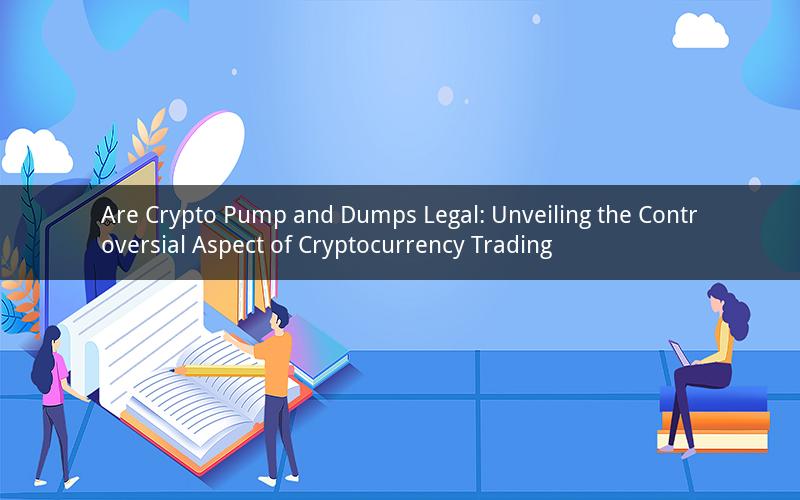
Introduction:
The world of cryptocurrencies has gained immense popularity in recent years, attracting both investors and traders. However, amidst the excitement, there exists a contentious practice known as "pump and dump." This article delves into the legality of pump and dump in the cryptocurrency market, exploring the various perspectives and shedding light on the ongoing debate.
1. What is a Pump and Dump?
A pump and dump is a fraudulent scheme employed in the cryptocurrency market, where a group of individuals manipulates the price of a digital asset by artificially inflating it (pumping) and then selling off their holdings at a higher price (dumping). The purpose of this scheme is to make a quick profit at the expense of unsuspecting investors.
2. The Legality of Pump and Dump:
The legality of pump and dump in the cryptocurrency market is a complex issue. While the act itself is illegal in many jurisdictions, the interpretation and enforcement of laws vary. Here's a closer look at the legal aspects:
a. Legal Status in Different Countries:
In some countries, such as the United States, pump and dump is considered illegal. The Securities and Exchange Commission (SEC) classifies it as a form of securities fraud, as it involves manipulating the price of a security (in this case, a cryptocurrency) for personal gain. Penalties for engaging in pump and dump can include fines, imprisonment, and the loss of assets.
b. Legal gray areas:
While pump and dump is illegal in many countries, some jurisdictions may have legal gray areas. For instance, in countries where cryptocurrencies are not classified as securities, the legality of pump and dump may be less clear. This ambiguity can make it challenging for authorities to enforce regulations and protect investors.
3. The Ethical Implications:
Apart from the legal aspects, pump and dump raises significant ethical concerns. This fraudulent practice undermines the integrity of the cryptocurrency market, leading to widespread skepticism and distrust. The following are some ethical implications:
a. Harm to Investors:
Pump and dump schemes can cause substantial financial harm to innocent investors who believe in the value of the cryptocurrency. By manipulating prices, pump and dumpers create artificial bubbles that eventually burst, leaving investors with significant losses.
b. Market Manipulation:
Pump and dump is a form of market manipulation that distorts the true value of a cryptocurrency. This can lead to misleading price signals, making it difficult for legitimate investors to make informed decisions.
4. How to Identify Pump and Dump Schemes:
Identifying pump and dump schemes is crucial for investors looking to protect themselves from falling victim to such fraudulent practices. Here are some indicators that may suggest a cryptocurrency is involved in a pump and dump scheme:
a. Rapid Price Increases:
If a cryptocurrency's price suddenly spikes without any substantial news or development, it may be a sign of a pump and dump scheme.
b. Low Trading Volume:
Low trading volume can indicate that the price increase is driven by a small group of individuals rather than genuine demand.
c. Hype and Promotional Activities:
Schemes often involve intense promotional activities, including social media campaigns, forums, and chat groups, aimed at manipulating public perception and driving up prices.
5. Combating Pump and Dump:
To combat pump and dump schemes, regulatory authorities and exchanges are implementing various measures:
a. Enhanced Regulation:
Regulatory bodies are working to classify cryptocurrencies as securities and establish stricter regulations to prevent pump and dump activities.
b. Transparency and Disclosures:
Exchanges are increasingly focusing on enhancing transparency and requiring disclosures from users engaging in large transactions.
c. Community Awareness:
Raising awareness among cryptocurrency investors about the risks of pump and dump schemes is crucial in preventing such fraudulent activities.
Conclusion:
The legality of pump and dump in the cryptocurrency market is a contentious issue, with varying interpretations and enforcement across different jurisdictions. While the act itself is illegal in many countries, the ethical implications and potential harm to investors make it a significant concern. By understanding the nature of pump and dump schemes and taking necessary precautions, investors can protect themselves from falling victim to this fraudulent practice.
Questions and Answers:
1. Is pump and dump illegal in all countries?
No, the legality of pump and dump varies by country. While it is illegal in many jurisdictions, some countries may have legal gray areas or lack clear regulations regarding the practice.
2. How can pump and dump schemes harm investors?
Pump and dump schemes can harm investors by causing significant financial losses, manipulating market prices, and creating artificial bubbles that eventually burst.
3. Can exchanges prevent pump and dump activities?
Exchanges are implementing measures such as enhanced regulation, transparency, and community awareness to combat pump and dump activities. However, completely eradicating such schemes is challenging due to the decentralized nature of the cryptocurrency market.
4. Are there any legal consequences for engaging in pump and dump?
Yes, engaging in pump and dump can have legal consequences, including fines, imprisonment, and the loss of assets. Regulatory authorities, such as the SEC, are actively investigating and penalizing individuals involved in such fraudulent practices.
5. How can investors protect themselves from pump and dump schemes?
Investors can protect themselves by staying informed, conducting thorough research, and being cautious of cryptocurrencies with sudden price spikes, low trading volume, and intense promotional activities. Additionally, staying aware of regulatory developments and following best practices in cryptocurrency investment can help mitigate risks.